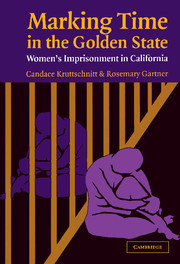Book contents
- Frontmatter
- Contents
- List of Figures and Tables
- Acknowledgments
- Marking Time in the Golden State
- 1 Introduction
- 2 Women, Crime, and Punishment in California
- 3 Entering the Prisons: Methods
- 4 Women's Experiences of Imprisonment at the California Institution for Women in the 1960s and the 1990s
- 5 Variations across Time and Place in Women's Prison Experiences
- 6 Negotiating Prison Life: How Women “Did Time” in the Punitive Era of the 1990s
- 7 Conclusion: The Spectrum of Women Prisoners' Experiences
- Appendix: Characteristics of Interviewees
- References
- Author Index
- Subject Index
6 - Negotiating Prison Life: How Women “Did Time” in the Punitive Era of the 1990s
Published online by Cambridge University Press: 15 December 2009
- Frontmatter
- Contents
- List of Figures and Tables
- Acknowledgments
- Marking Time in the Golden State
- 1 Introduction
- 2 Women, Crime, and Punishment in California
- 3 Entering the Prisons: Methods
- 4 Women's Experiences of Imprisonment at the California Institution for Women in the 1960s and the 1990s
- 5 Variations across Time and Place in Women's Prison Experiences
- 6 Negotiating Prison Life: How Women “Did Time” in the Punitive Era of the 1990s
- 7 Conclusion: The Spectrum of Women Prisoners' Experiences
- Appendix: Characteristics of Interviewees
- References
- Author Index
- Subject Index
Summary
to this point, our analysis of women's imprisonment in California has concentrated on how temporal and institutional factors shape prisoners' responses to their carceral environments. We found that both factors are important. The California Institution for Women (CIW) in the 1990s had only partial success in translating the goals of the new punitive era to its inhabitants largely because of its tenure and legacy in California's imprisonment history; but at Valley State Prison for Women (VSPW), an institution whose tenure began in the 1990s, the effects of the recent transformations in penalty are clearly more discernable. In this final chapter, we consider the extent to which the kinds of institutional distinctions we have drawn remain important for how women do time once we take into account women's personal attributes and life experiences. To do this, we expand our analysis, which to this point has largely relied on interviews, to incorporate information we obtained from our respondents to the surveys we administered. We develop a measure of, or operationalize the concept of, “doing time” by using latent class analysis. While less nuanced than our previous analyses, in what follows we hope to provide both a more representative picture of how women do time in the 1990s and a more complete description of the factors that help to determine their different responses to imprisonment.
- Type
- Chapter
- Information
- Marking Time in the Golden StateWomen's Imprisonment in California, pp. 121 - 156Publisher: Cambridge University PressPrint publication year: 2004



